Books
Books
published in 2024

this simulation sux
Jr Ting Ding, DeForrest Brown Jr.
this simulation sux is a collection of speculative essays and personal observations commissioned by global cultural institutions and local counterculture zines between February 2020 and April 2021.
"During the moment of pause brought on by the initial lockdown, we chose to write as a form of self care and mediated therapy; writing, for us, is a way to process, orient, and grasp for a moment of clarity in the ever changing media and cultural landscape. In this informational era, in which our attention is in very high demand, the amount of content we are expected to consume is endless. Beset with political unrest, economic uncertainty, and waning emotional bandwidth, we have become datapoints in the vast and saturated marketplace presented to us as “society.”
[...]
Flânerie, the French term describing the act of walking and observing, became a part of our daily ritual; we lapped the outer edges of the island of Manhattan and exploring various neighborhoods during the peak of the pandemic. The images presented on this book’s jacket were captured on these walks, documenting the absurdities of everyday life in this fraying simulation. Personal, anecdotal narratives of an imagined reality are represented through the images, which are placed alongside our speculative observations derived from historical data.
We hope that these writings can provide others with prose and information that can be applied like an antidotal balm to treat our communal ailment of future shock."
—Ting Ding 丁汀 & DeForrest Brown, Jr.

Fraitaxtsēs sores tsîn ge ra≠gâ – Ondjembo yo Null Vier
A complete documentation on a multimedia exhibition by Berlin-based artist Ixmucané Aguila, giving voice to voiceless descendants of victims of genocide in Namibia.
Genocide in Namibia is an especially sensitive matter—its history has at times been ignored, underestimated, or even denied outright. In the artistic documentary Fraitaxtsēs sores tsîn ge ra≠gâ – Ondjembo yo Null Vier, Ixmucané Aguilar has worked in close collaboration with Nama and OvaHerero people who vividly evoke memories and rituals of mourning caused by human loss and land dispossession under Imperial Germany's violent occupation.
From these personal encounters emerge portraits, visuals and narratives as documental fragments, consisting of living voices which insist on defending memory as an invocation to witness and never to remain passive in the face of social injustice. Rather than a linear collection of data referring to distant places and its distant past, this work engages with stories as chronicles calling to be recognised as pieces of humanity and time.
Alongside Aguilar's portraits, this publication also contains contributions by human rights attorney Wolfgang Kaleck and the curator of the work Tristan Pranyko, along with poetry by Namibian artists Nesindano Namises, Fritz Isak Dirkse and Prince Kamaazegi, and narratives, testimonies, chants and mourning rituals shared by OvaHerero and Nama people in present-day Namiba.
Published on the occasion of the eponymous exhibition at National Art Gallery of Namibia, Windhoek, in 2023
Ixmucané Aguilar (born 1983) is a Guatemalan Berlin-based visual artist/designer who, through multi-layered documentary photography, engages in extensive field research to put out installations and art publications to relay her work in an artistic language.
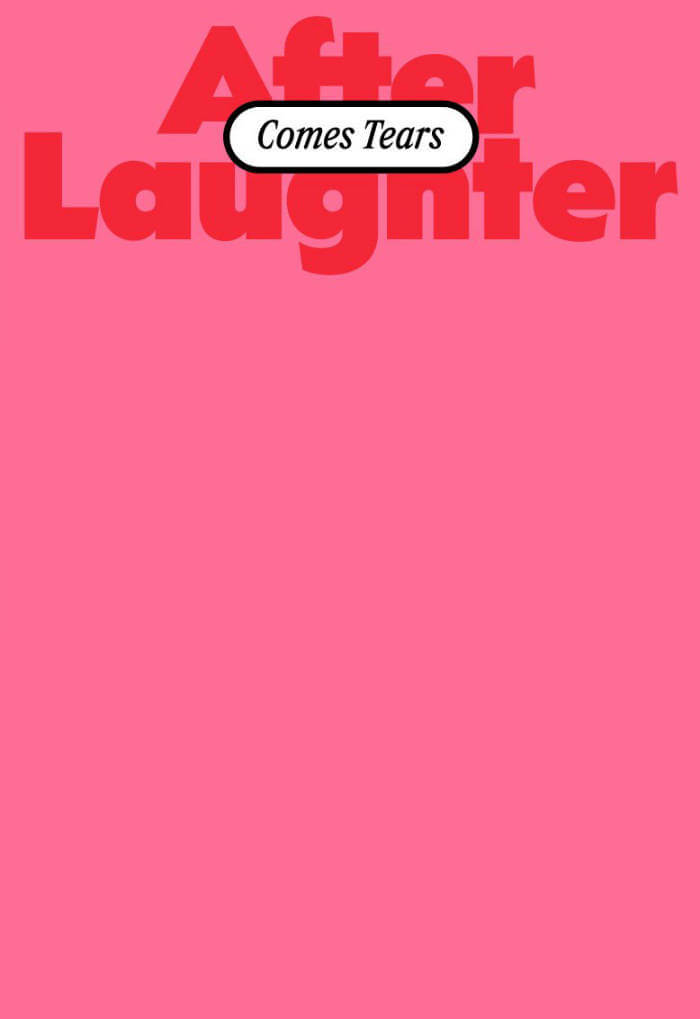
After Laughter Comes Tears
Joel Valabrega, Clementine Proby and 1 more
After Laughter Comes Tears, in its exhibition and book forms, brings together artists from different generations who are experimenting with the idea of the performative. This publication follows the structure of the exhibition at Mudam Luxembourg, with a prologue, four acts and an epilogue, which each sample excerpts from the range of theory, fiction and poetry that inspired and substantiate the themes of the exhibition. Widening the spectrum of the traditional catalogue, each artist was given a "carte blanche"—an invitation to contribute to the book on their own terms.
This performative book was conceived as a story; a story of the pains, joys, anxieties and doubts of the 2020s. It takes as a starting point, the feelings of stasis and anger that define the present stage of late capitalism, framed by the anxieties of a generation facing a climate crisis, welfare states trampled and failed by neoliberal policies and the rise of xenophobia around the globe, partly fueled by fake news spreading on- and offline. It is an intuitive journey through the voices of thirty-four artists expressing the lurid shapes of the crises that surround us and form a (never exhaustive) part of our contemporary reality.
They are Cem A., Panteha Abareshi, Monira Al Qadiri, Kate Cooper, Pauline Curnier Jardin, Jesse Darling, Stine Deja, Omer Fast, Anna Franceschini, Guan Xiao, Sidsel Meineche Hansen, Lukáš Hofmann, Christian Jankowski, Chris Korda, Ndayé Kouagou, Ghislaine Leung, Isaac Lythgoe, Taus Makhacheva, Diego Marcon, Jacopo Miliani, Marie Munk, Chalisée Naamani, Agnieszka Polska, PRICE, Jean-Charles de Quillacq, Mika Rottenberg, Julika Rudelius, Dorian Sari, Sin Wai Kin, Shinuk Suh, Martine Syms, Mungo Thomson, Cajsa von Zeipel, and Artur Żmijewski.
Edited by Clarisse Fahrtmann, Clementine Proby, Joel Valabrega.
Foreword by Bettina Steinbrügge.
Contributions by Kate Cooper, Lukas Hofmann, David McDermott, Markus Pilgram, Agnieszka Polska, Clémentine Proby, Sin Wai Kin, Bettina Steinbrügge, Geraldine Tedder, Joel Valabrega, Lauren Wetmore.

Material Marion von Osten 1 – MoneyNations
The first volume in a series devoted to Marion von Osten's archives, around the MoneyNations project, transversing between art, theory, and activism.
MoneyNations was an exhibition, a webzine, a radio, a conference, a video archive, a printed publication, an infrastructure, a counterpublic, an ongoing discussion, a transnational network of friends. Initiated by Marion von Osten as curator at the Shedhalle Zurich, the project evolved from an urgency to act against the hegemonic forces of "the West" within the radically changing condition of post-Cold War Europe. MoneyNations addressed—and intervened in—the interrelatedness between racist border policies and media representations, exploitative economic relations, and identity-forming processes. The applied methods of critique and organizing, transversing between art, theory, and activism, are made accessible in this volume through images, correspondences, and other ephemera, revealing their political potential for the present. It is contextualized by a conversation between Sezgin Boynik (Rab-Rab Press), Ferdiansyah Thajib (KUNCI Study Forum & Collective), Eleanor Ivory Weber, Camila Willis (Divided Press) and the editors.
The Material Marion von Osten series periodically publishes selected archival documents from von Osten's projects and contextualizes them with new contributions. Correspondences, drafts, scripts, photographs, videos and printed matter serve as the starting point for the publication series which maps the complexity of Marion von Osten's transversal cultural production in its details and specifics.
The artist, curator, researcher, and educator Marion von Osten (1963-2020) lived in Berlin since the early 1990s. Her always collaborative approach manifested in exhibitions, conferences, installations, as well as films, discussions, texts, teachings, or self-published journals. Her projects were all intertwined and carried by her specific way of working: through artistic research and feminist organizing, transnational and committed to the project of decolonization. Amongst her works are the international exhibition series bauhaus imaginista (2018-2020), Viet Nam Discourse (2016-2018) at Tensta Konsthall, Project Migration (2002-2006) in Cologne, and Sex & Space (1996) at Shedhalle Zurich. As collective infrastructures, her collaborations included Labor k3000, kleines postfordistisches Drama (Minor Postfordist Drama, kpD) and the CPKC Center for Postcolonial Knowledge and Culture.
Edited by Lucie Kolb, Jonas von Lenthe, Max Stocklosa.
Conversation between Sezgin Boynik, Ferdiansyah Thajib, Eleanor Ivory Weber, Camila Willis and the editors.
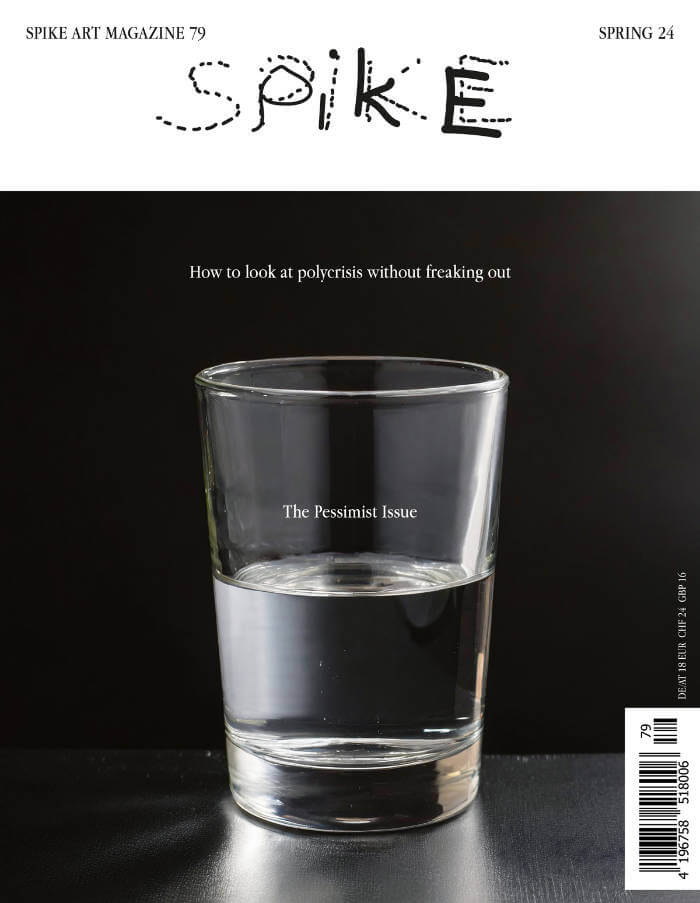
Spike #79 – The Pessimist Issue
How to look at polycrisis without freaking out.
Eco ruin and refugeeism, illiberalization and inequality, hot wars and a New Cold War—the polycrisis hydra is always growing another head. But it's also a state of mind, an identity crisis brought on by paralysis and cognitive shock. Was it always like this, but with less media reach? Or is capitalism really burning itself out, just without any redemptive zest? The arts are expert at thematizing the woes that affect them—hello, Biennale and documenta—but maybe polycrisis is an instructive metaphor for what's breaking creativity: the commercial takeover of discourse, the bureaucratization of curating, and the dopamine highs of self-branding.
Maybe we're at a crossroads between recovery and death. But Spike #79 is clear-eyed about the fact that pessimists are never disappointed.
With Henrike Naumann, Shirin Neshat, Roberto Villanueva, Ben Davis, Mire Lee, Precious Okoyomon, Ivan Cheng, Nil Yalter, Anselm Franke, Anna Jermolaewa, Catherine Liu, Oliver Ressler, Morag Keil, Jeppe Ugelvig and many more.
Founded by the artist Rita Vitorelli in 2004, Spike (Spike Art Quarterly) is a quarterly magazine on contemporary art published in English which aims at sustaining a vigorous, independent, and meaningful art criticism. At the heart of each issue are feature essays by leading critics and curators on artists making work that plays a significant role in current debates. Situated between art theory and practice and ranging far beyond its editorial base in Vienna and Berlin, Spike is both rigorously academic and stylishly essayistic. Spike's renowned pool of contributing writers, artists, collectors and gallerists observe and reflect on contemporary art and analyse international developments in contemporary culture, offering its readers both intimacy and immediacy through an unusually open editorial approach that is not afraid of controversy and provocation.

Mu, 49 Marks of Abolition
In March 2020, Sora Y. Han learned her father was dying of cancer just as the COVID-19 pandemic arrived on California's shores. These two events led Han to introspection: “Who have I been writing to?” and “Who have I been writing for?” In her observance of the 49 days of mourning in Buddhist tradition, answers come in the form of mu – no thing, nothingness.
Han’s poetic meditations on freedom struggle come alive in the empty spaces between words, letters, and pictograms spanning her many languages—English, Korean, Chinese, jazz, law, and poetry.
Transliterating and dystranslating the writings of Fred Moten, Theresa Hak Kyung Cha, Jacques Lacan, Frantz Fanon, and others through the Korean alphabet, Han weaves the DMZ, Betty’s Case, the Thirteenth Amendment, Afro-pessimism, and psychoanalytic desire together into the open field of Bay Area radicalism. Mu is both a loving homage to and a playful subversion of political inheritances and the unsayable beyond law.
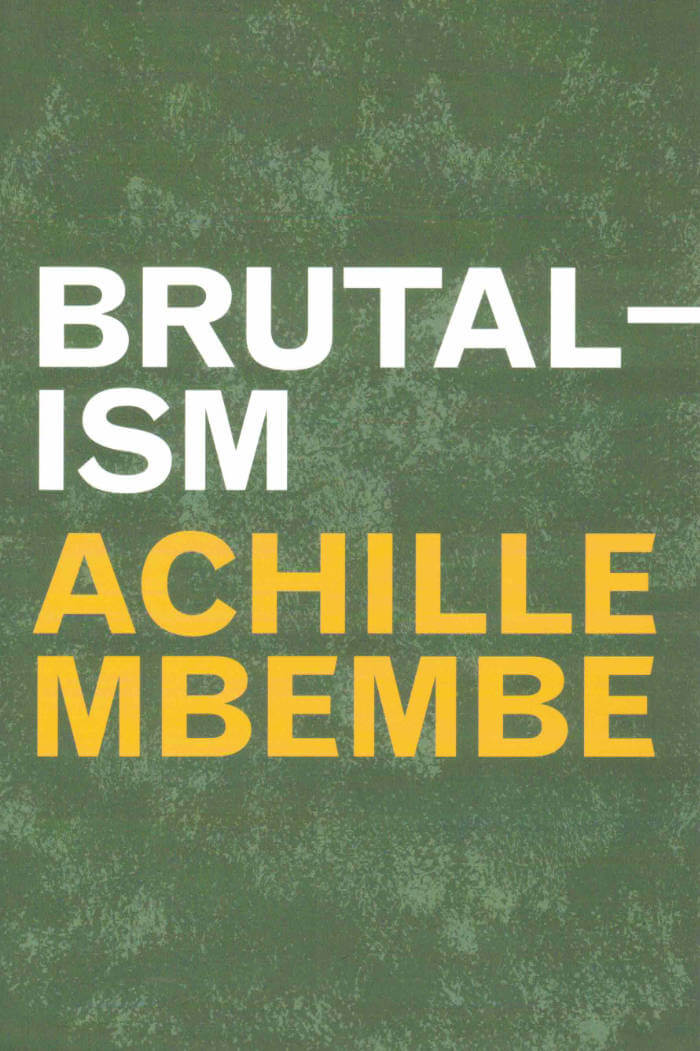
Brutalism
In Brutalism, eminent social and critical theorist Achille Mbembe invokes the architectural aesthetic of brutalism to describe our moment, caught up in the pathos of demolition and production on a planetary scale.
Just as brutalist architecture creates an affect of overwhelming weight and destruction, Mbembe contends that contemporary capitalism crushes and dominates all spheres of existence. In our digital, technologically focused era, capitalism has produced a becoming-artificial of humanity and the becoming-human of machines. This blurring of the natural and artificial presents a planetary existential threat in which contemporary society’s goal is to precipitate the mutation of the human species into a condition that is at once plastic and synthetic.
Mbembe argues that Afro-diasporic thought presents the only solution for breaking the totalizing logic of contemporary capitalism: repairing that which is broken, developing a new planetary consciousness, and reforming a community of humans in solidarity with all living things.
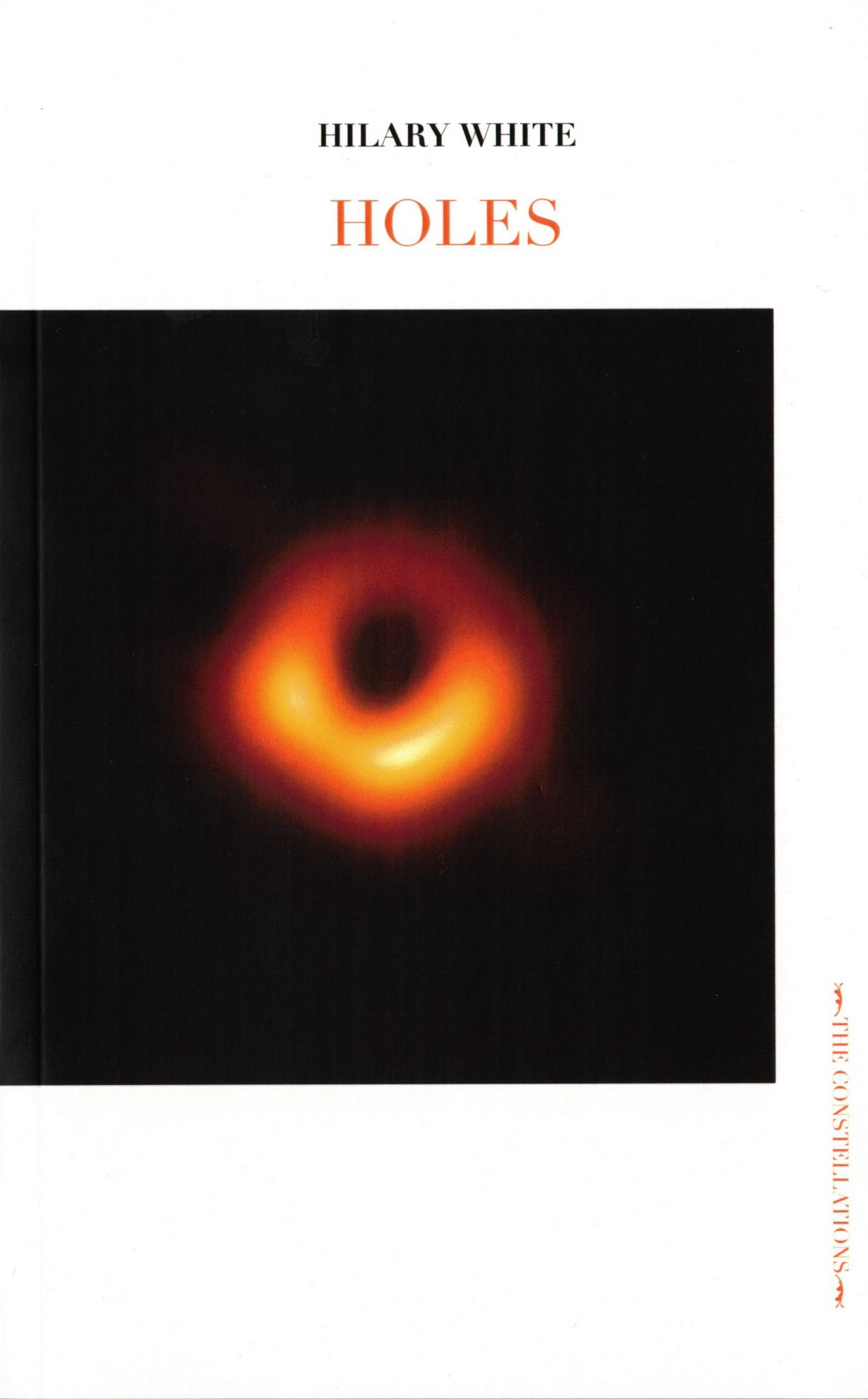
Holes
Sometimes I pretended not to notice it (the black hole), but I knew it was always there. To tell the truth, I started to like having it around. I stuck quite close to it. Not too close, mind you. But it was useful, above all, to have somewhere to put things. Unwanted things. I am attracted to your attraction, he said. (I put it in the hole.) Night by night it got a little bigger.
Holes splices forms of fiction and nonfiction. The narrator, a researcher of limits at an unidentified university, figures her entanglement with an unobtainable love object as the descent into a black hole. Everything she reads seems to shed light on the non-events that comprise their relationship, and study collapses into life as she struggles to separate events and forms, reality and ideation. Holes is a study in thematic fixation, engaging a range of ‘obsessional artists’ (including Yayoi Kusama, from whom the term is borrowed, Lee Bontecou, and Carolee Schneemann) for whom holes—as idea, imagery, philosophy—have proved evocative, inviting, and occasionally obliterative.
Hilary White is a writer and researcher, currently an IRC postdoc at Maynooth University, Ireland, working on a project entitled Forms of Sleep. She co-ran the experimental poetry reading and commission series, No Matter, in Manchester, and co-edited the zine series, Academics Against Networking. Her writing appears in MAP, Banshee, zarf, and The Stinging Fly. Holes is her first novel.

Feet of Clay
Curator, art historian, writer Chus Martínez and writer and curator Filipa Ramos bring together a group of artists who have been using clay, pottery and ceramics to imagine, project and shape the world they live in.
Some may associate clay, pottery and ceramics to tradition, and tradition to the past. Some may associate technology, digital communication and data with the new, and the new with the future. What if the future is only a technology as old and unusual as clay? What if clay is a matter that renews itself constantly and gives time its unpredictable configurations?
What if clay is the future and the future is clay? And if the feet of clay only reveal a vulnerability because the rest of the body is made of a different material? And if the feet of clay are actually rooting people to the earth, connecting them through the same matter? And if feet of clay are a way to establish a post-technological communication that requires no webs, no networks, no cables; only our many, one, two, eight, twenty feet and some clay?
These are some of the questions and enigmas addressed by curators Chus Martínez and Filipa Ramos, who brought together a group of artists who have been using clay, pottery and ceramics in an exhibition entitled Feet of Clay, presented at Galeria Municipal do Porto in 2021. Like clay, the project has now been moulded into book format, bringing together exclusive texts and interviews with the participating artists: Neïl Beloufa, Isabel Carvalho, Gabriel Chaile, Pauline Curnier Jardin, Formabesta (Salvador and Juan Cidrás), Tamara Henderson, Ana Jotta and Eduardo Navarro.
Texts by Neïl Beloufa, Isabel Carvalho, Gabriel Chaile, Pauline Curnier Jardin, Formabesta (Salvador e Juan Cidrás), Tamara Henderson, Ana Jotta, Chus Martínez, Eduardo Navarro, Filipa Ramos.

Scrapyard Abstraction
Machteld Rullens' second publication with Zolo Press documents three years of works, friends & family moments, and travels in Senegal, NYC, LA, and Vincent van Gogh's house…
"A friend told me my works are "warmly laconic" without becoming ironic or cynical. They show serious material research with humor and a dark side. In this book, I share my personal life and way of working. It might clarify my obsession with art, art history, the studio, travels I made, and the way I use my analog camera. My work has become more mature and I've turned a little grey myself. In the work I use all the possibilities of the box. Paint and surface become one. The cardboard is not a background that is separate from the paint. In this way, I expand my visual research, which I do not only as a painter but also as a sculptor. The pictures taken over the past years were made while spending time in a small village in Senegal, in Vincent van Gogh's house, my studio in The Hague, Los Angeles, Brussels, and my friend's place in Germany." — Machteld Rullens
Machteld Rullens (born 1988 in The Hague, Netherlands) works with sculptural elements that have a strong link with painting but are rarely applied with a brush. She uses everything that's available and that reflects her basic mood. That mood is a reflection of the time and of the world that, in spite of all its beauty, is overstimulated and possible even bored. Her wall objects, made from found cardboard boxes and epoxy resin, are full of emptiness. Rullens started painting on cardboard boxes when she ordered art supplies for the studio and noticed that the boxes could be tackled in a far more aggressive and impulsive way than for example a blanc canvas. She shapes and rearranges the cardboard boxes, something that was once fragile into something sturdy, relating to elements of play, composition, and architecture.
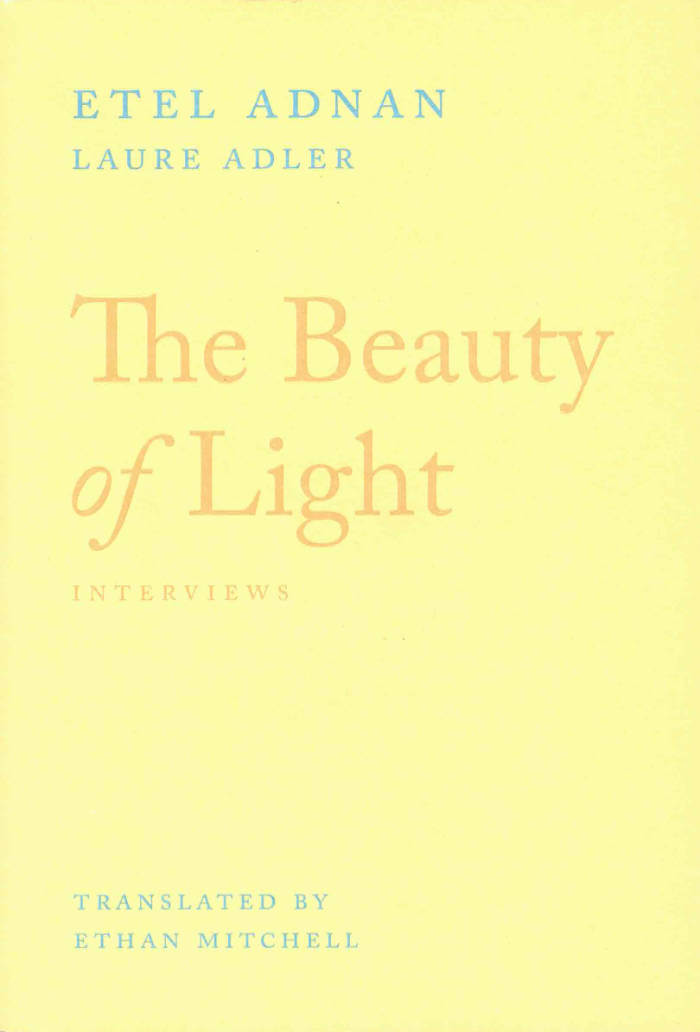
The Beauty of Light: An Interview
A lively and spontaneous interview with Etel Adnan about her absolute belief in the beauty of the world, the beauty of art.
In these interviews conducted by journalist Laure Adler, poet and painter Etel Adnan recounts the foundational experiences of her artistic approach shortly before her death in Autumn of 2021. From her youth in Lebanon, through her years in New York and California, and her late-in-life discovery at Documenta in 2013, this intimate conversation revisits and questions the sometimes difficult destiny of women.

Tiffany Sia: On and Off-Screen Imaginaries
This collection of writings by artist and filmmaker Tiffany Sia (born 1988) gathers six essays that offer a framework for fugitive cinema. Written in the wake of the 2019-20 Hong Kong Protests ignited by the Anti-Extradition Bill Movement, Sia's writings survey the rise of a new documentary vernacular being produced by a wave of emerging filmmakers breaking from the nostalgia of Hong Kong's cinematic golden age. As a practitioner and thinker, Sia has been at the forefront of a nascent generation of artists working to trace social unrest and political crackdowns. Drawing from personal experience and historical study, her writings offer urgent reflections on a cultural landscape changed by censorship and surveillance.
An essential counterpart to her oeuvre, this volume is a critical intervention into global film studies, the politics of film/photographic practices and experimental approaches to documentary. Film stills from filmmakers Chan Tze-woon and the anonymous collective Hong Kong Documentary Filmmakers, photographs by artist An-My Lê and images from Sia's short film The Sojourn (2023) are interspersed between each essay, inviting the reader to consider a cinema by other means.

Zoo Index - Reader (volume 1)
Zoo Index Reader examines the relevance and effect that zoos have in shaping our gaze towards non-human animals and by extension ourselves/each other.
Through a mixture of visual research into zoological space—in the form of an A-Z glossary—and written contributions on the history of menageries, the confinement and privatization of land, pets, zoo architecture, the "naturalization" of animals, and the role of zoos and animals in the history of cinema, among many other things, this first volume asks: Do we need zoos? What does a meaningful coexistence with animals look like? Why have we decided to give a balloon to an elephant?
With Terezie Štindlová, jacob lindgren, A+E Collective, Chanelle Adams, John Berger, Andrea Branzi, David Hancocks, Eliot Haworth, Institute for Postnatural Studies, Suzanne van der Lingen, Angelo Renna, Laurel Schwulst, Richard Weller.
Designed by Terezie Štindlová

Aube
Caroline Bachmann's dawn paintings.
Caroline Bachmann's paintings owe as much to turn-of-last-century Symbolism—in their attempt to depict an infinite stillness, whose synthetic depiction of nature could be mistaken for that of eternity—as to plein air painting. The artist lives and works on the shore of Lake Geneva, where she spends hours contemplating the scenery, recording with a lead pencil on paper minute details of atmospheric events, making notes in the margins of subtle colour changes—not unlike comic book colourists of the pre-digital age, whose job it was to pass on to engravers written codes corresponding to the 64 possible combinations of percentages of cyan, magenta, yellow and black at their disposal. Back in the studio, the paintings are then built up over a lengthy period of time with translucent glazes of oil paint.
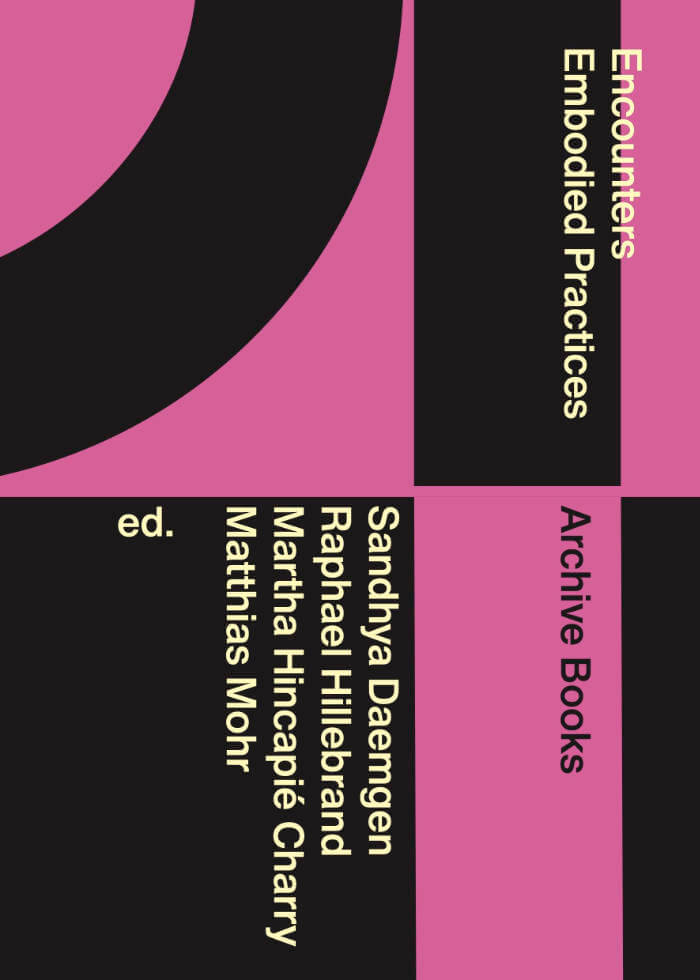
Encounters – Embodied Practices
Sandhya Daemgen, Raphael Hillebrandt and 2 more
Conversations about embodied strategies of knowledge production and knowledge transmission based on the choreographic and curatorial practices of about fifteen international choreographers, performers, dramaturges and curators.
In the context of the numerous ethical-political challenges of the global present, actors from the dance and choreography scene both in Berlin and internationally talk about forms of knowledge production beyond the prevailing conception found in Western modernity. They counter the mind-body separation and the notion of a universality of knowledge with multiplicities of knowledge production that emerge with and from the reality of differently situated bodies.
What potential do embodied practices offer for emancipatory movements? How can community be created through these practices, and what responsibilities does this entail? What role does the body play in the preservation and transmission of knowledge?
In this publication, edited by the choreographers and curators Martha Hincapié Charry, Sandhya Daemgen, Raphael Moussa Hillebrand and Matthias Mohr; Lukas Avendaño, Wagner Carvalho, Sandhya Daemgen, Ismail Fayed, Alex Hennig, Raphael Moussa Hillebrand, Martha Hincapié Charry, Isabel Lewis, Matthias Mohr, Prince Ofori, Mother "Leo" Saint Laurent, Léna Szirmay-Kalos, Thiago Granato and July Weber conduct conversations about embodied strategies of knowledge production and knowledge transmission based on their respective choreographic and curatorial practices.

Pour des écoles d'art féministes !
Nelly Catheland, Adèle Bornais and 1 more
A collective manifesto for feminist art schools.
Bringing a series of intersectional feminist lectures, interviews, workshops and discussion groups back to an art school is crucial to sharing tools for emancipation and challenging the implicit criteria that structure our views and practices (identification with Western visual norms, romantic-capitalist representations of the artist-author, etc.). It is vital to give a voice to artists and those who support them in the ways in which they deal with, and even elude, relations of power.
The primary aim of this book is to share the content hosted and produced at the École Supérieure d'Art de Clermont Métropole between 2017 and 2022. It is also an opportunity to work with a group of students, artists and researchers, to think about how invitations and the production of the book can be drawn up collectively; it is a tool for collective and ideally horizontal pedagogical work within a hierarchical and hierarchizing institution. The invitations, transcription and editing of the texts were done jointly.
Edited by Lilith Bodineau, Adèle Bornais, Nelly Catheland, Charlotte Durand, Martha Fely, Lola Fontanié, Eulalie Gornes, Chloé Grard, Sophie Lapalu, Eden Lebegue, Michèle Martel, Sarah Netter, Clémentine Palluy, Mauve Perolari, Simon Pastoors, Rune Segaut, Danaé Seigneur.
Texts by Nino André & Vinciane Mandrin, Rachele Borghi, Tadeo Cervantes, Adiaratou Diarrassouba, Kaoutar Harchi, T*Félixe Kazi-Tani, Nassira Hedjerassi, Gærald Kurdian, H.Alix Sanyas, Sophie Orlando, Émilie Renard, Liv Schulman, Danaé Seigneur, Pau Simon.

Histoire de la séparation
Pour les révolutionnaires des deux derniers siècles, l’accumulation du capital devait unifier la classe ouvrière sous la bannière du sujet révolutionnaire. Le mouvement ainsi né était appelé à renverser la société de classes et les clivages divisant les prolétaires. Mais le mouvement de la valeur a finalement triomphé, pour donner naissance à la société de la séparation. L’atomisation a pris le pas sur les puissances du rassemblement. La civilisation du capital traverse aujourd’hui une crise sans fin, mais les forces capables de la défaire brillent par leur absence.
Ces textes tirés de la revue Endnotes, réunis pour la première fois en français, dessinent la carte d’un présent ponctué de paysages désindustrialisés, de centres logistiques et de bidonvilles où s’entassent les populations rejetées aux marges de l’accumulation – autant de coordonnées nécessaires pour continuer à penser le dépassement du capitalisme : une fois encore, reprendre le chantier de l’hypothèse communiste.
Endnotes est une revue théorique communiste produite par un groupe de discussion du même nom basé en Grande-Bretagne et aux États-Unis.
Traduction: Pablo Arnaud
Préface: Aaron Benanav Et John Clegg
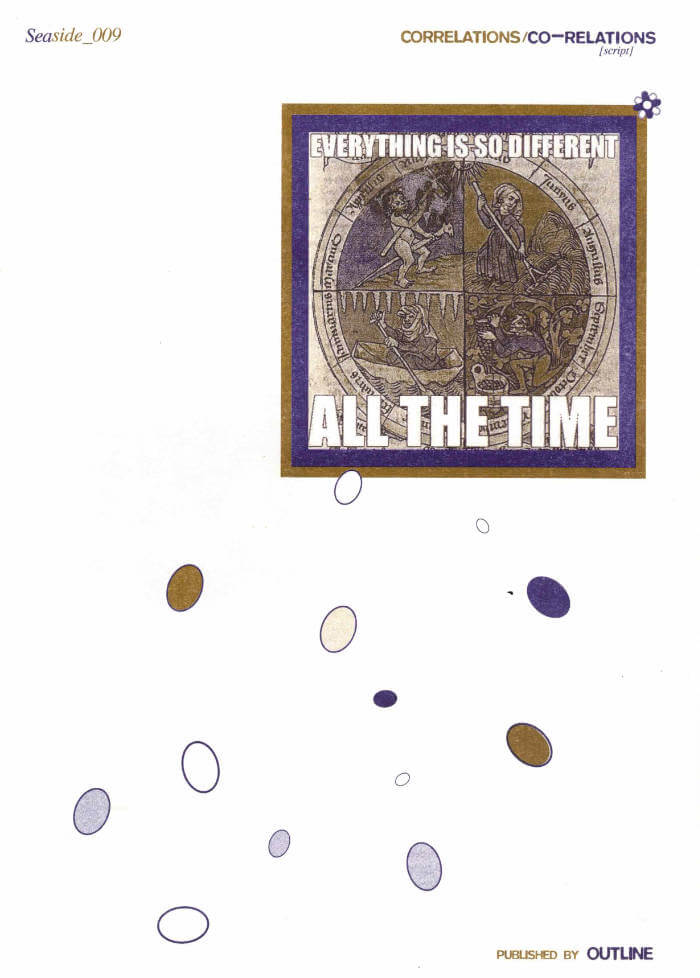
Seaside_009: Correlations/co-relations
Seaside_009: Correlations/co-relations: was read and listened to collectively during a gathering on 13 October 2023 during BYOB Art Book Fair at Enter Enter in Amsterdam. This loosely connected patchwork of bootlegged texts and collected sounds all deal with notions of the archive and the remix in some way or another. Together they form a soft proposal for a publishing practice based around dubbing, multivocality and “speaking nearby”.

The Lowell Re:Offering - Conjuring the Ghosts of Lowell
A poetic script, an apocalyptic newspaper, and a syntax of intersected historical narratives. An investigation of an archive of writings previously published in The Lowell Offering, a periodical issued between 1840-1845 by women factory workers in Lowell, Massachusetts.
Design by Daria Kiseleva

Dreams of a Dreamless Night
The publication is the first institutional monograph on the multimedia practice of artist and director Ali Cherri. It aims to highlight the constellation of ideas, themes, and formal concerns running through his most recent, highly significant projects.
Edited by Alessandro Rabottini and Leonardo Bigazzi, with Bianca Stoppani, this book provides an overview of the artist's output over the past three years, teasing out both new strands for interpretation and formal links between his films, videos, sculptures, drawings, and installations.
Texts by: Cecilia Alemani, Erika Balsom, Étienne Bernard, Leonardo Bigazzi, Ali Cherri, Lorenzo Giusti, Stefanie Hessler, Priyesh Mistry, Alessandro Rabottini, Stefan Tarnowski.
Video and visual artist Ali Cherri (born 1976 in Beirut, lives and works in Paris and Beirut) received a BA in graphic design from the American University in Beirut in 2000, and an MA in performing arts from DasArts, Amsterdam, in 2005. His current project looks at the place of the archaeological object in the construction of historical narratives.
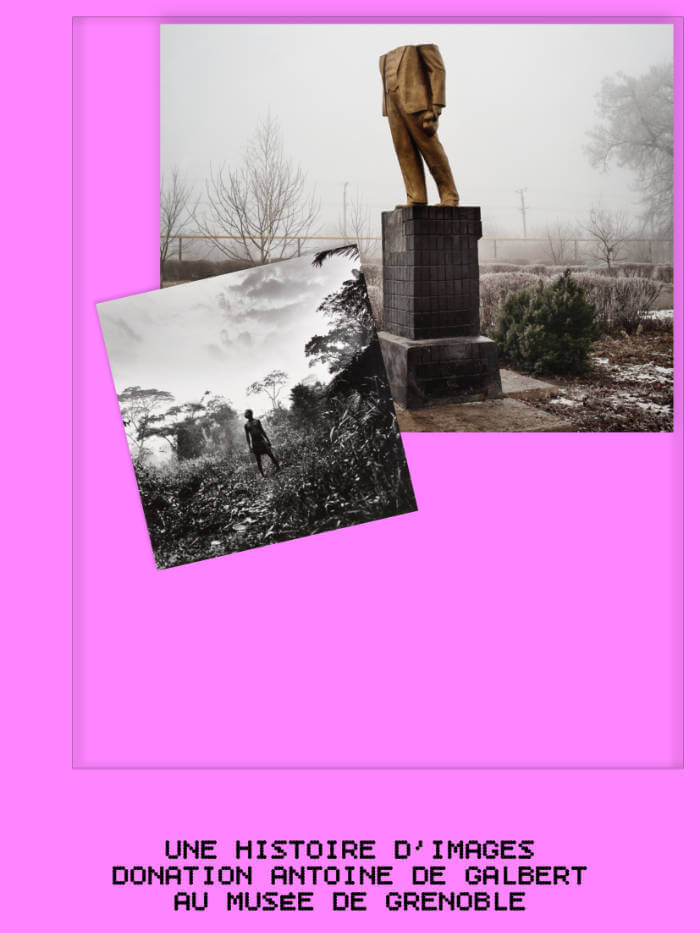
A history of images / Une histoire d'images
Noëlig Le Roux, Guy Tosatto and 1 more
Through more than 500 images by 95 photographers, the Musée de Grenoble's collection of photographs from Antoine de Galbert's collection and his foundation offers an impressive panorama of our times and the decisive role played by photography in shaping our perceptions and contemporary mythologies.
Works by Aalam, Bani Abidi, Antoine d'Agata, Lucien Aigner, Pilar Albarracín, Yolanda Andrade, Sammy Baloji, Ion Bîrlădeanu, Eric Baudelaire, Philippe Bazin, Guillaume Binet, Alain Bizos, Antoni Campana, Mario Carnicelli, Henri Cartier-Bresson, Jean-Philippe Charbonnier, Chieh-Jen Chen, Roman Cieslewicz, Christian Courrèges, David Damoison, Philippe De Gobert, Luc Delahaye, Bernard Descamps, Jean-Marie Donat, Alfred Eisenstaedt, Sandra Eleta, Fouad Elkoury, Charles Fréger, Alberto García-Alix, Laurence Geai, Agnes Geoffray, Julien Gester, Stephan Gladieu, David Goldblatt, Hengameh Golestan, Cosmin Gradinaru, Guillaume Herbaut, Chester Higgins, Kati Horna, John Isaacs, Olivier Jobard, Alain Keler, Yevgeny Khaldeï, Chris Killip, Sirkka-Liisa Konttinen, Oleg Kulik, Olivier Laban-Mattei, Stéphane Lagoutte, Dorothea Lange, Le Tiers Visible, Arthur Leipzig, Alexandre Lewkowicz, Pascal Maître, Yuri Mechitov, Davood Maeili, Edouard Méhomé, Georges Melet, Lívia Melzi, Boris Mikhaïlov, Lisette Model, Etienne Montes, Yan Morvan, Genevieve Naylor, Vladimir Nikitin, Martin Parr, Paolo Pellegrin, Mathieu Pernot, Gilles Raynaldy, Marc Riboud, Sophie Ristelhueber, Hugo Schmölz & Karl Hugo Schmölz, Chantal Stoman, Paul Strand, Mikhael Subotzky, Barthélémy Toguo, Tomasz Tomaszewski, James-Iroha Uchechukwu, Alex Van Gelder, Erwan Venn, Weegee, Where dogs run, Sue Williamson, Wiktoria Wojciechowska, Pavel Wolberg, Tom Wood, Patrick Zachmann, Miron Zownir.
Texts by Antoine de Galbert, Guy Tosatto, Noëlig Le Roux, Antoine Champenois, Joséphine Givodan.
Published on the occasion of the eponymous exhibition at the musée de Grenoble from December 2023 to March 2024.

"If you slap the water, you hurt the heads of the fish"
The first comprehensive monograph devoted to artist Bea Schlingelhoff.
Conceived on the occasion of Bea Schlingelhoff's solo exhibition No River to Cross at Kunstverein München, this publication extends far beyond this to survey fifteen years of her artistic practice through imagery, ephemera, and various texts. Additionally, the publication brings together five newly commissioned pieces of writing, penned by Catherine Chevalier, Gloria Hasnay, Christina Irrgang, Helene Moll, and Sadie Plant, each focusing on a specific body of Schlingelhoff's work. Each book is one of a kind and bound in different endpapers from the private collection of the artist's father.
Edited by Gloria Hasnay.
Texts by Catherine Chevalier, Gloria Hasnay, Christina Irrgang, Helene Moll, Sadie Plant.

Lava Lines
Lava Lines explores the life forms, contemporary myths and geopolitical powers that shape volcanic landscapes. It gathers poetry, role play's transcription, film scripts and visual works of several artists, to touch on collective memory, non-human agency and myth-making.
The art works presented in the publication are by Leïla Arenou, Francisca Khamis, Naïmé Perrette, Camille Picquot, Rachel Pimm, Francisca Khamis, Juliette Lizotte, Riar Rizaldi and Arif Kornweitz
It also archives live performances/screenings by Francisca Khamis, Arif Kornweitz, Mika Oki, Chooc Ly Tan, Adán Ruiz, Ana Vaz, and Rieko Whitfield.

God Made My Face: A Collective Portrait of James Baldwin
Baldwin's life and legacy as remembered by a pantheon of artists and writers: from Jamaica Kincaid and Barry Jenkins to Richard Avedon and Alice Neel.
When author James Baldwin died in 1987, he left behind an extraordinary body of work: novels, poems, film scripts and, perhaps most indelibly, essays. A friend and supporter of Martin Luther King Jr., Malcolm X and Medgar Evers, Baldwin was a critical voice in the civil rights movement. After reaching acclaim in his early career as a writer, he struggled to retain the author's "I," while taking on the "we" of the people.
Edited by Pulitzer Prize-winning author Hilton Als and growing out of his landmark exhibition at David Zwirner in 2019, God Made My Face brings together an impressive assembly of contributors, ranging from Baldwin biographer David Leeming to novelist Jamaica Kincaid and Moonlight director Barry Jenkins, to create a memorial mosaic: one that not only mirrors Baldwin's various tones but also closely examines his singular contributions to cinema, theater, the essay and Black American critical studies. These essays are illustrated by artwork from modern and contemporary artists who were either personal contemporaries of Baldwin or directly inspired by his work. In each piece assembled here, the authors speak from a personal, informed perspective, illuminating Baldwin's deeply anguished and enlightened voice and his belief that, ultimately—because we are human—we share the potential to love, connect and live together in all our glory.
Artists include: Diane Arbus, Eugène Atget, Richard Avedon, Don Bachardy, Alvin Baltrop, Anthony Barboza, Njideka Akunyili Crosby, Beauford Delaney, Marlene Dumas, Glenn Ligon, George McCalman, Alice Neel, Elle Pérez, Cameron Rowland, Kara Walker, James Welling, Larry Wolhandler.
Authors include: Stephen Best, Daphne A. Brooks, Teju Cole, Marianne Jean-Baptiste, Barry Jenkins, Jamaica Kincaid, David Leeming, Darryl Pinckney.